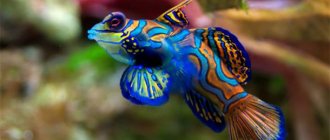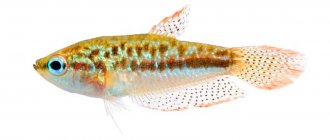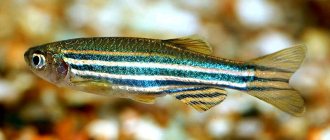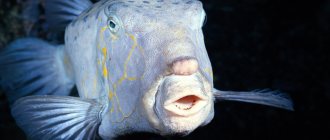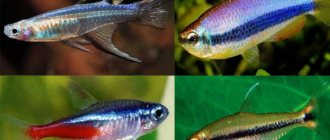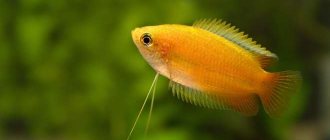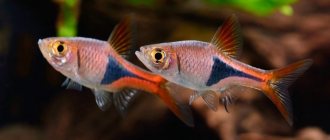Characteristics of pearl fish
As a rule, fish from the carp
, which belong to the lechefeathers.
The history of the name of this group of living organisms is quite fascinating. One day, one of the pearl fishermen discovered a translucent snake-like creature inside the valves of an oyster. During its stay in the “house,” the fish managed to turn pearlescent, which gave the false impression that it itself had a pearl color.
Depending on the degree of independence of their existence, we can distinguish:
- Eking out a parasitic existence inside invertebrate hosts such as bivalves, ascidians, starfish and sea cucumbers. Most often, crappies choose so-called sea cucumbers as their “home” and live in their anal pores, eating their eggs.
- Having a symbiotic relationship with their owner.
- Synanthropic - use the body of another living creature as a home, but do not harm it in any way and do not benefit it.
- Free-living - this is how all “ pearl oysters
” live in the larval state. In this state they live among plankton. The embryos typically have a long filament in front of the dorsal fin, which has various appendages.
In 1977, a New Zealand biologist recorded about 15 species of these fish, most of which lived in the body of a sea cucumber.
Appearance
Like all gouramis, the pearl-like body is laterally compressed. The scales are painted silver with a violet tint . Closer to the back, the color changes to light green, and near the belly it has coral shades.
In addition to the main palette, pearl spots are scattered throughout the body and fins (see photo). Another decoration is a dark longitudinal stripe along the body. The maximum length of the fish is 12 cm. Life expectancy is 6-8 years.
The selective form of the pearl balloon gourami looks exotic: while maintaining the basic color, the fish has acquired a short disc-shaped body and a hump.
Where are pearl fish found?
Carp live in the tropical waters of the following oceans:
The habitat depth is quite high and can reach a couple of kilometers. A typical dwelling is located in the area of ocean slopes and gently sloping bottom.
Due to their tiny size and the almost complete lack of means to repel aggression, these fish are forced to spend a significant part of their lives inside other larger organisms.
And only with the onset of darkness their time comes, and they swim out of the owner’s body in order to feed.
Nutrition and behavioral characteristics
A varied and balanced diet is the key to proper development and good health of fish. The gourami menu should include live and dry food .
Twice a day they can be given live cyclops, daphnia, bloodworms, tubifex a. Special dry food for labyrinth fish is sold in pet stores. The dose for one feeding is prescribed on the package.
Important! Gourami have a small mouth, so dry food must be thoroughly crushed, rubbing it between your fingers when feeding.
Shy by nature, gourami never conflict, they are shy and cautious. When kept with other fish, the owner will have to pay close attention to ensure that they do not starve.
Pearl sea fish: how to cook
The most delicious bleak dish is sprats. However, the cooking process is quite labor-intensive and requires a lot of patience.
We list the main steps in preparing the dish:
- Catch or buy several kilograms (up to five) of fish.
- Place the entire catch in one large container and gut each fish. The surface layer comes off very easily, you can do everything only with your hands without using sharp objects. After the procedures, the carcasses need to be washed thoroughly.
- The entire volume of fish must be salted with an amount of salt that is 10 times less than the weight of the fish itself. After this, keep the dish in a cool place for 24 hours. During this time, the carcasses will release juice and acquire significant elasticity.
- Take a large saucepan and lay out the bleak layer by layer. Sprinkle each layer generously with spices - pepper, bay leaf, cloves.
- This entire “pie” is filled with sunflower oil to the very edges - so that all the fish is covered.
- Place to simmer in the oven.
- Then put the finished dish in glass jars, which can wait in the refrigerator until winter.
Compatibility
A peaceful nature is a plus and a minus for gourami. They get along without problems with many aquarium inhabitants .
However, they cannot be housed with aggressive fish: the same swordtails can mercilessly tear off the long ventral fins of pearl beauties.
Good compatibility
Neons, zebrafish, rasboras, and angelfish are good neighbors. Some aquarists keep gourami and large species of shrimp together.
Poor compatibility
cichlids, barbs, swordtails, veiltails and goldfish is dangerous for them .
Kutum: long-lived fish
Another inhabitant of the deep sea called carp or kutum has a silvery-pearl shade of scales. Most often it can be found in the south of European Russia. Its lifespan is extremely long - more than ten years, which is rare for fish.
The teeth of representatives of this group of organisms are very developed. This allows the fish to feast on a wide variety of inhabitants of the sea and rivers:
- Soft-bodied;
- Arthropods;
- Invertebrates;
- Worms;
- Insects.
As soon as an individual turns five years old and reaches a mass of a couple of kilograms, it begins to reproduce. However, the reproduction of this species lags far behind the scale of its extermination. Uncontrolled fishing by Russian fishermen has led to the fact that kutum is in danger of extinction. The species has already been listed in the Red Book, but this does not help it much at the moment.
Almost any inhabitant of the deep sea that has a pearly tint can deserve the name “pearl fish.” What it is cannot be answered unequivocally. Depending on the context, they may mean kutum, bleak or carp. The latter most often bear such a proud nickname: for example, in the world they are called pearlfish
.
Answers to crossword puzzle AiF 50 2021
Answers to the crossword puzzle AiF 50 2021 (12/15/2021)
- 1. On the bank of which river does breakfast take place in Francisco Goya’s painting? (a hidden word of 10 letters).
- 5. What fictitious island gave its name to the literary genre? (a hidden word of 6 letters).
- 9. Tropical chicken laying Easter eggs. (a hidden word of 6 letters).
- 10. “Cognac peak.” (a hidden word of 6 letters).
- 11. Prince from the ballet “Sleeping Beauty”. (a hidden word of 6 letters).
- 12. Hollywood sex symbol, often wearing a Scottish suit with a kilt. (a hidden word of 6 letters).
- 13. Talking goat by Kir Bulychev. (a hidden word of 7 letters).
- 16. The beginning of holiness. (a hidden word of 11 letters).
- 18. “... in the last resort.” (a hidden word of 6 letters).
- 19. Frenchman, whose work is considered the prologue of the European Rococo style. (a hidden word of 5 letters).
- 20. Small fraction. (a hidden word of 4 letters).
- 26. Which Greek did Edith Piaf marry in church? (8 letter hidden word).
- 29. “Raking” oars. (a hidden word of 7 letters).
- 30. There, behind the clouds. (a hidden word of 4 letters).
- 31. What can you throw away? (a hidden word of 5 letters).
- 32. Ceramics of coffee services. (a hidden word of 6 letters).
- 36. Financial invoice. (a hidden word of 7 letters).
- 39. Suit for extreme descent from heaven. (8 letter hidden word).
- 40. Historical memoirs that immortalized the name of Anna Comnena. (mystery word of 9 letters).
- 44. Who voices what is written? (a hidden word of 4 letters).
- 47. War game. (8 letter hidden word).
- 48. Defense of the knight. (a hidden word of 4 letters).
- 51. Language sensations. (a hidden word of 4 letters).
- 52. Real name of Jean Gabin. (8 letter hidden word).
- 53. Robot with a human face. (a hidden word of 6 letters).
- 54. Chili from a bottle. (a hidden word of 4 letters).
- 55. Hero from the jungle in the books of the American Edgar Burroughs. (a hidden word of 6 letters).
- 56. Benefit from a runaway father. (8 letter hidden word).
- 57. Paparazzi bag. (a hidden word of 4 letters).
- 1. The commander whose troops prevented Field Marshal Erich von Mainstein from escaping from the Stalingrad cauldron. (a hidden word of 11 letters).
- 2. Note writer. (a hidden word of 7 letters).
- 3. What kind of surprise do gangsters use? (a hidden word of 11 letters).
- 4. A maid with the face of Natalia Gundareva from the musical film “Truffaldino from Bergamo”. (a hidden word of 11 letters).
- 6. Which actress was first mentioned in Charles Dickens's will? (a hidden word of 6 letters).
- 7. “Driveway” of the stairs. (a hidden word of 6 letters).
- 8. “Stone gifts” of the sea. (a hidden word of 6 letters).
- 12. With what class did Ivan the Terrible quarrel? (a hidden word of 5 letters).
- 14. How did Herodotus baptize the primitive tribes that lived in Africa? (mystery word of 9 letters).
- 15. An alternative to democracy. (mystery word of 9 letters).
- 17. What constellation can be found in the savannah? (a hidden word of 5 letters).
- 21. It’s a profitable business. (a hidden word of 4 letters).
- 22. Serial hero from Melmac. (a hidden word of 4 letters).
- 23. “Angel of Love.” (a hidden word of 4 letters).
- 24. What are ABBA playing in their video for the song “The Name of the Game”? (a hidden word of 4 letters).
- 25. Synonym for tomato. (a hidden word of 5 letters).
- 27. Which star warms humanity? (a hidden word of 6 letters).
- 28. Shoes for taking penalties. (a hidden word of 5 letters).
- 33. Singer from the video “I’ll go and cry a little.” (a hidden word of 4 letters).
- 34. Foreign car from the film “Hitchhiker” by Nikita Mikhalkov. (a hidden word of 4 letters).
- 35. Unscrupulous grabber. (a hidden word of 4 letters).
- 36. Which French cinema star suffered from persecution mania all his life? (a hidden word of 5 letters).
- 37. Masculine burden. (a hidden word of 7 letters).
- 38. Favorite designer of actress Lily Collins. (a hidden word of 7 letters).
- 41. Patriarch of the Moscow Art Theater, who obtained any deficit through fame. (a hidden word of 5 letters).
- 42. A piece of white filling. (a hidden word of 6 letters).
- 43. Musical fragment from a medley. (a hidden word of 6 letters).
- 45. Who won an Oscar for playing serial killer Aileen Wuornos? (a hidden word of 5 letters).
- 46. Which poem was the last one Sergei Yesenin read publicly? (a hidden word of 5 letters).
- 47. Which TV detective was played by David Suchet? (a hidden word of 5 letters).
- 49. Japanese snack roll. (a hidden word of 4 letters).
- 50. Mayor of a city in Kazakhstan. (a hidden word of 4 letters).
- 53. Wise python. (a hidden word of 3 letters).
Answers to the crossword puzzle from Arguments and Facts 50 2021 (12/15/2021) : 1. Mansares. 5. Utopia. 9. Tinamu. 10. Ararat. 11. Desiree. 12. Butler. 13. Napoleon. 16. Abstinence. 18. Truth. 19. Watteau. 20. Iota. 26. Lambukas. 29. Blade. 30. Heights. 31. Focus. 32. Porcelain. 36. Texture. 39. Wingsuit. 40. Alexiad. 44. Reader. 47. Paintball. 48. Armor. 51. Taste. 52. Monkorge. 53. Cyborg. 54. Sauce. 55. Tarzan. 56. Alimony. 57. Case
1. Malinovsky.
2. Student. 3. Suddenness. 4. Smeraldina. 6. Ternan. 7. Railing. 8. Amber. 12. Boyars. 14. Garamants. 15. Dictatorship. 17. Giraffe. 21. Experience. 22. Alpha 23. Cupid. 24. Ludo. 25. Tomato. 27. Sun. 28. Boots. 33. Alsou. 34. Fiat. 35. Rvach. 36. Funes. 37. Ballast. 38. Westwood. 41. Yanshin. 42. Apple. 43. Hit. 45. Theron. 46. Flowers. 47. Poirot. 49. Roll. 50. Akim. 53. Kaa. Answers to the crossword puzzle AiF 50 2021https://krosswordscanword.ru/wp-content/uploads/2020/09/otvety-na-krosswordy-AiF.jpg https://krosswordscanword.ru/wp-content/uploads/2020/09/ otvety-na-krosswordy-AiF-240×236.jpg2021-12-14T17:53:19+04:00 adminAnswers to crossword puzzlescrossword Answers to crossword puzzle AiF 50 2021 (12/15/2021) 1. On the bank of which river does breakfast take place from a painting by Francisco Goya ? (a hidden word of 10 letters). 5. What fictitious island gave its name to the literary genre? (a hidden word of 6 letters). 9. Tropical chicken laying Easter eggs. (a hidden word of 6 letters). 10. “Cognac peak.” (mysterious…admin AdministratorCrosswords, Scanwords
Diseases
Pearl gouramis have strong natural immunity and rarely get sick. Health problems arise when the temperature is incorrect. Let's tell you more about some diseases.
Lymphocystosis
A viral disease affecting fish scales and mucous membranes. In a sick individual, blisters appear on the body, which gradually increase in size .
Having reached a maximum, the blisters burst, releasing the virus into the aquarium water.
Attention! The first signs of lymphocystosis appear on the fins of the fish.
The pet can be saved if the blisters on the fins are immediately burned. If the infection has spread to the body, the fish will have to be destroyed.
Pseudomonosis
A disease of bacterial nature. It is brought into the aquarium by infected plants, soil and other fish. In the initial stage, dark spots appear on the fish’s body , then they transform into bleeding ulcers.
The sick individual must be transferred to a separate container filled with a solution of potassium permanganate (0.5 g per 10 liters of water) and kept there for 15 minutes. The procedure is repeated with a break of 1 day for a week.
Aeromonosis
A dangerous infectious disease caused by Aeromonos punctata . It is provoked by low temperature and dirty water. Sick individuals lose their appetite, stop swimming and lie down on the bottom.
Blood stains appear on the body and fins, and the abdomen swells. This is a contagious disease that has almost no cure, so the affected fish are destroyed and the aquarium is thoroughly disinfected.
Disease Prevention
To avoid encountering such diseases, you should be responsible for the rules of keeping gourami . Prevention measures:
- give food in strictly defined doses, in no case overfeed the fish;
- monitor the hardness and acidity of the water;
- do not allow the water temperature to drop below 26 °C;
- do not feed with food obtained from nature;
- periodically disinfect the soil and decorations.
Keeping pearl gourami in a home aquarium is a pleasure, the main thing is to adhere to the rules of their maintenance.
Peaceful and beautiful fish live a measured life; they swim gracefully in the water column, pleasing the eye with a pearlescent glow.
History of discovery
The genus Trichogaster, to which the pearl gourami is classified, was founded in 1801 by two German scientists: ichthyologist Markus Bloch and naturalist Johann Schneider. The literal translation of the word trichogaster defines the main feature of fish of this genus (thread-like rays of the pectoral fins), from the derivatives thrix - hair and gaster - belly.
The species itself was discovered in 1852 by the Dutch ichthyologist Pieter Blecker. Gourami appeared in European aquariums in 1865 thanks to the French naturalist Pierre Carbonnier. He was actively involved in the acclimatization of tropical fish on the European continent. On expeditions to Southeast Asia, Blecker caught wild specimens of threadworts and delivered them to Paris in wooden barrels. Initially, such an event ended in the death of the animals, until scientists assessed the vital functions of the fish.
In the 19th century, the pearl species was discovered by the French naturalist Pierre Carbonnier.
Having noticed the ability of gourami to breathe atmospheric air, the barrels for transportation were not completely filled with water. Thanks to this approach, the fishtails successfully endured the forced “journey” and took root in aquariums on the European continent. Pearl gourami was brought to Russia in 1947.
In the international classification, the species is identified as Trichogaster leeri and is known to aquarists under other names: tulle fish, mosaic gourami, pearl trichogaster.
Torakatum
Takarkatums are one of the most common catfish in our aquariums. Their popularity is due to the unpretentiousness of keeping, endurance and peaceful disposition of these fish.
Latin name: Hoplosternum thoracatum.
Correct name: Many call this fish tArakatum, probably comparing it with a cockroach, but it is still correct to say thorakatum, from the Latin “thorax” - shell.
Synonyms: Torakatum, hoplosternum, catfish thoractum, tarakatum catfish.
Order, family: Armored catfish.
Water temperature: 22-28° C.
Ph “acidity”: 5.8-7.5.
dH: Up to 25°.
Aggressiveness: 0% non-aggressive.
Content difficulty: Very easy
Compatibility: virtually any fish - these catfish - do not pose any threat to other inhabitants of the aquarium.
Cockerels or Bettas
A very beautiful fish, its veiled tail and fins are simply mesmerizing. The colors of the fish are different. The most common color is inky with a reddish tint. Males are much brighter in color and have longer fins than females. The size of the fish is up to 7 cm.
Order, family: labyrinthine.
Comfortable water temperature: 22-24°C.
Ph: 6.0-7.5.
Aggression: Males are aggressive towards each other. During spawning, the male and female can kill each other.
Compatibility: with all peaceful fish. You should not put them with swordtails, barbs, and especially with cichlids.
Cichlazoma black-striped
Black-striped cichlasoma is one of the most popular fish of the cichlasoma family. These are relatively small, unpretentious fish, with a beautiful, sophisticated body color and, importantly, unlike many cichlids, they have a calmer character.
Latin name: Cichlasoma nigrofasciatum. From the Latin words “nigro” - black and “fascia” - ribbon, belt, stripe.
Russian synonyms: Black-striped cichlazoma, black-striped cichlamosis, black-striped cichlamosis.
Foreign names: Zebra Cichlid, Zebra chanchito, Convict Cichlid, Zebrabuntbarsch Grunflossenbuntbarsch, Blaukehlchen.
Order, suborder, family: Perciformes, Perciformes, Cichlidae.
Comfortable water temperature: 20-28°C.
“Acidity” Ph: 6.8-8.0.
Hardness dH: 8-30°.
Aggressiveness: 30% are relatively non-aggressive, they show aggression during the period of spawning and caring for offspring.
Content difficulty: easy.
Some might say that the peak of their popularity has passed, that now there are many other more colorful forms of cichlids and cichlases in particular. However, the statistics don’t lie! Today, the black-striped cichlasoma, the most popular of all cichlasomas in the Yandex search. Every month more than 2200 users of this search engine apply for this request.
We also recommend looking at the colorful brochure
See also: Roman geese, Laika the astronaut, Dolly the sheep and other animals that changed human history
Astronotuses
These fish can hardly be called easy to keep, since they belong to the cichlid family, moreover, they are large, predatory fish. Nevertheless, thanks to their beauty, their qualities: behavior, intelligence, astronotuses have gained a leading position in popularity among cichlids.
Order, family: cichlids.
Comfortable water temperature: 22-28 C.
Ph: 6.0-7.5.
Aggressiveness: aggressive 99%.
The volume of the aquarium for astronotus should be from 300 to 500 liters.
Aeration, filtration, and regular water changes (weekly 30%) are required. Particular attention should be paid to filtration; it should be powerful (a second filter would be useful). The aquarium can be decorated with large stones and driftwood; the decor should not be sharp. Provide shelter for the fish.
Reviews
Pearl gourami are leisurely and peaceful fish that will become a real decoration of the aquarium. The elegant color of iridescent flowers combined with a pearlescent scattering of white “pearls” makes the fish one of the most beautiful representatives of the genus.
Have you kept “pearl” fish in an aquarium? Share your experience and opinion about them in the comments.
Corridors
This is a family of chain catfish. Popular, easy to keep, unpretentious, peaceful catfish. They have intestinal respiration.
Corydoras
Order, family: armored catfish.
Comfortable water temperature: 24-25° C.
Ph: 6.0-7.0.
Aggressiveness: non-aggressive.
Compatibility: any fish. The only undesirables are Labeo, Botia modesta, and Ancistrus, because they chase them (although it's more like a game). Large cichlids are also not the best neighbors. The most famous catfish and excellent aquarium orderlies, keeping them with goldfish will ensure the cleanliness of the soil in the aquarium.
